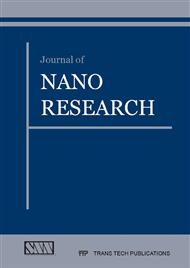[1]
J. Zbiljic, O. Vajdle, V. Guzsvany, J. Molnar, J. Agbaba, B. Dalmacija, K. Kalcher, J Hazard Mater, 283 (2015) 292-301.
Google Scholar
[2]
C. Cai, Z. Zhang, J. Liu, N. Shan, H. Zhang, D.D. Dionysiou, Applied Catalysis B-Environmental, 182 (2016) 456-468.
Google Scholar
[3]
J. Deng, Y.S. Shao, N.Y. Gao, C.Q. Tan, S.Q. Zhou, X.H. Hu, J Hazard Mater, 262 (2013) 836-844.
Google Scholar
[4]
G. -D. Fang, D.D. Dionysiou, Y. Wang, S.R. Al-Abed, D. -M. Zhou, J Hazard Mater, 227 (2012) 394-401.
Google Scholar
[5]
Z.H. Wang, R.X. Yuan, Y.G. Guo, L. Xu, J.S. Liu, J Hazard Mater, 190 (2011) 1083-1087.
Google Scholar
[6]
Y.Q. Pi, J.L. Feng, J.Y. Sun, M.K. Song, J.H. Sun, Environ Sci Pollut R, 21 (2014) 3031-3040.
Google Scholar
[7]
A. Rodríguez, G. Ovejero, J. Sotelo, M. Mestanza, J. García, Ind Eng Chem Res, 49 (2009) 498-505.
DOI: 10.1021/ie901212m
Google Scholar
[8]
P.R. Shukla, S. Wang, H. Sun, H.M. Ang, M. Tadé, Applied Catalysis B: Environmental, 100 (2010) 529-534.
Google Scholar
[9]
F. Qi, W. Chu, B.B. Xu, Chem Eng J, 235 (2014) 10-18.
Google Scholar
[10]
C. Cai, H. Zhang, X. Zhong, L.W. Hou, J Hazard Mater, 283 (2015) 70-79.
Google Scholar
[11]
Q. Chen, F. Ji, Q. Guo, J. Fan, X. Xu, J Environ Sci-China, 26 (2014) 2440-2450.
Google Scholar
[12]
S.N. Su, W.L. Guo, Y.Q. Leng, C.L. Yi, Z.M. Ma, J Hazard Mater, 244 (2013) 736-742.
Google Scholar
[13]
L.J. Xu, W. Chu, L. Gan, Chem Eng J, 263 (2015) 435-443.
Google Scholar
[14]
I.V.B. a.G.E.M. Andreas Öchsner, J Nano Res-Sw, 16 (2008) 123-128.
Google Scholar
[15]
Y. Qu, W. Zhou, H. Fu, Chemcatchem, 6 (2014) 265-270.
Google Scholar
[16]
A.V. Vinogradov, V.V. Vinogradov, T.V. Gerasimova, A.V. Agafonov, J Alloy Compd, 543 (2012) 172-175.
Google Scholar
[17]
J. Lu, Y. Jiang, Y. Zhang, J. Huang, Z. Xu, Ceram Int, 41 (2015) 3714-3721.
Google Scholar
[18]
S. Rasalingam, R.T. Koodali, CrystEngComm, (2016).
Google Scholar
[19]
S. Royer, D. Duprez, F. Can, X. Courtois, C. Batiot-Dupeyrat, S. Laassiri, H. Alamdari, Chemical Reviews, 114 (2014) 10292-10368.
DOI: 10.1021/cr500032a
Google Scholar
[20]
S.N. Tijare, M.V. Joshi, P.S. Padole, P.A. Mangrulkar, S.S. Rayalu, N.K. Labhsetwar, Int J Hydrogen Energ, 37 (2012) 10451-10456.
DOI: 10.1016/j.ijhydene.2012.01.120
Google Scholar
[21]
J. Zhu, H. Li, L. Zhong, P. Xiao, X. Xu, X. Yang, Z. Zhao, J. Li, Acs Catalysis, 4 (2014) 2917-2940.
Google Scholar
[22]
Y. Qu, W. Zhou, H. Fu, ChemCatChem, 6 (2014) 265-270.
Google Scholar
[23]
K. Wangkawong, S. Suntalelat, D. Tantraviwat, B. Inceesungvorn, Materials Letters, 133 (2014) 119-122.
DOI: 10.1016/j.matlet.2014.06.158
Google Scholar
[24]
Z. Zhu, H. Yu, J. Li, J Nano Res-Sw, 17 (2012) 1-12.
Google Scholar


